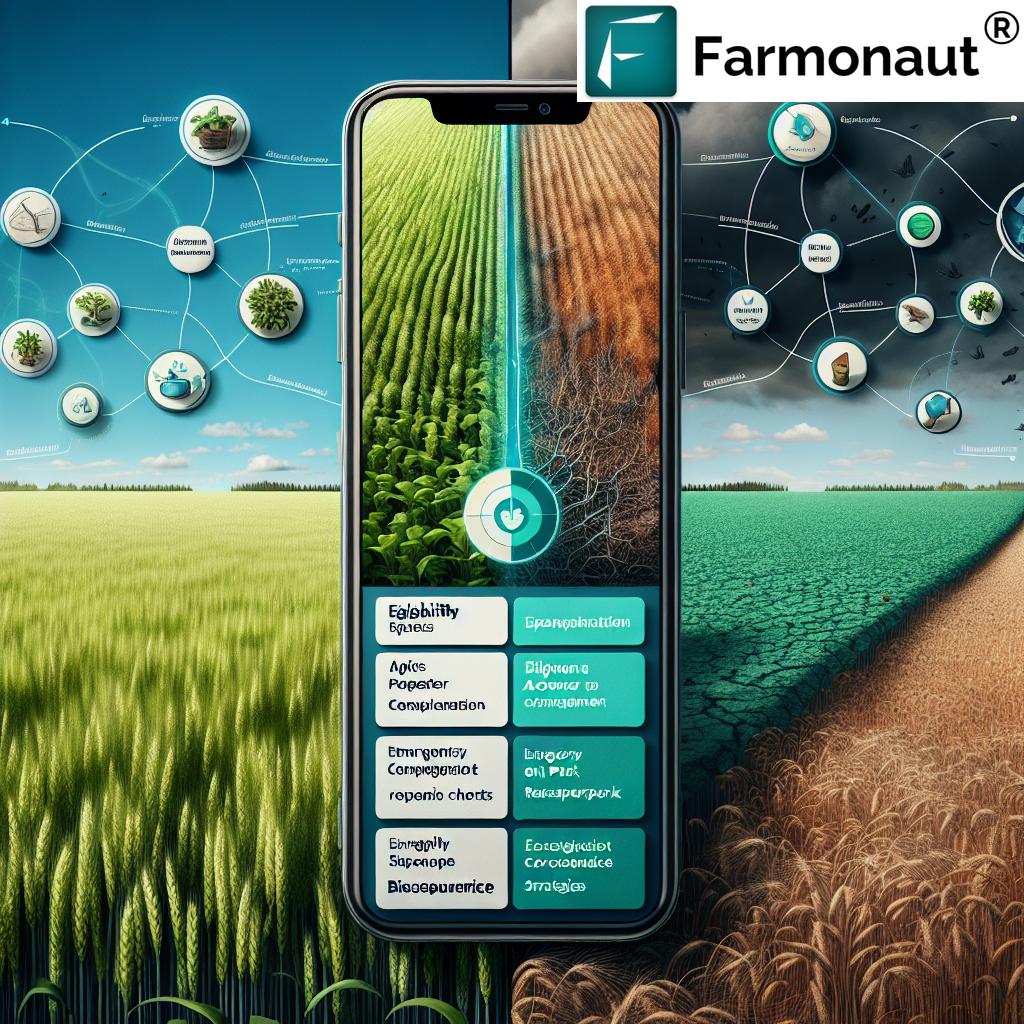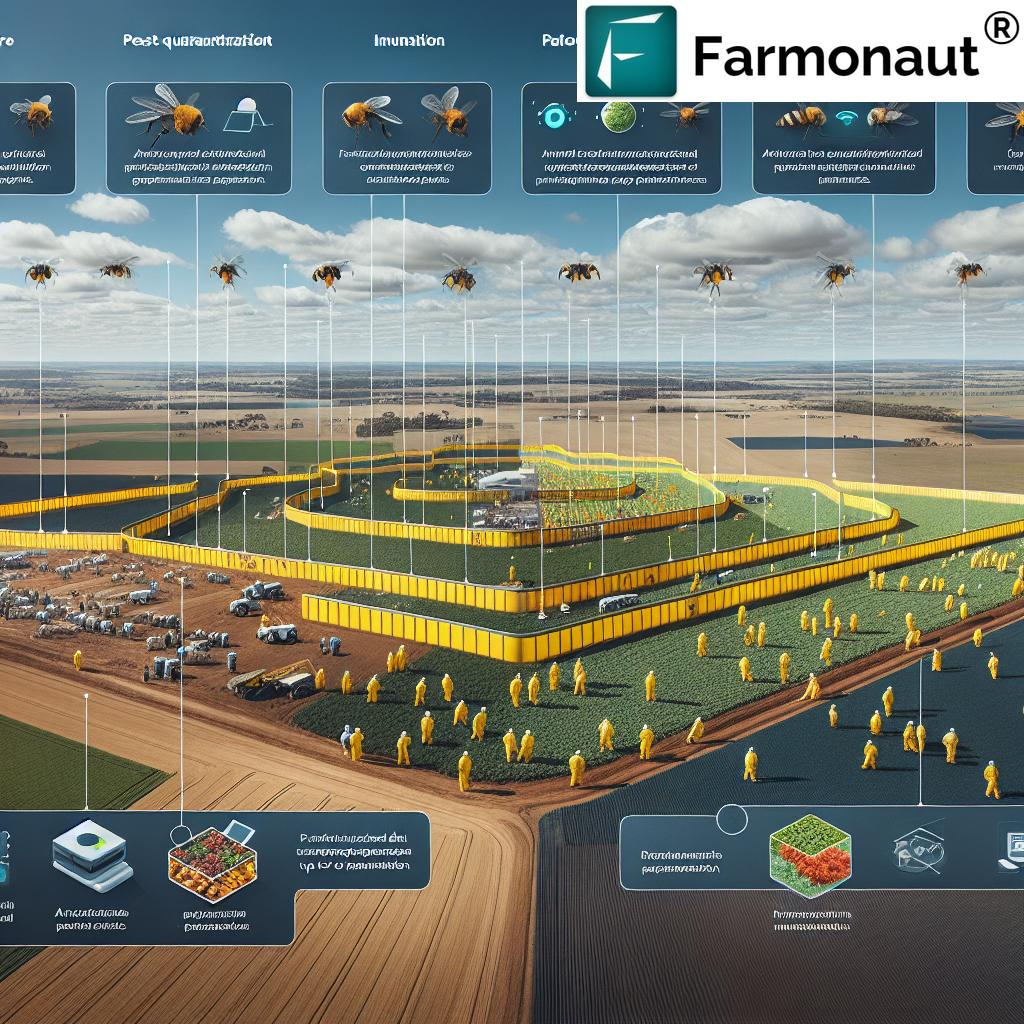Navigating Australia’s Emergency Plant Pest Response: A Comprehensive Guide to Owner Reimbursement Costs for Farmers
“The Emergency Plant Pest Response Deed (EPPRD) covers direct eradication expenses and destroyed crop values for eligible Australian farmers.”
In the ever-evolving landscape of Australian agriculture, biosecurity remains a paramount concern for farmers, industry bodies, and government alike. At Farmonaut, we understand the critical importance of maintaining plant health and supporting our agricultural sector during times of crisis. That’s why we’re delving deep into the intricacies of Australia’s Emergency Plant Pest Response and the vital Owner Reimbursement Costs (ORC) framework that underpins it.
This comprehensive guide aims to shed light on the complex world of crop quarantine compensation and agricultural disaster response. We’ll explore how the Emergency Plant Pest Response Deed (EPPRD) provides crucial support for growers facing biosecurity challenges, outline the specific circumstances under which farmers may be eligible for financial compensation, and detail the payment processes involved in this industry-shaping framework.
Understanding the Emergency Plant Pest Response Deed (EPPRD)
The EPPRD is a cornerstone of Australia’s biosecurity measures for farmers, representing a unique partnership between government and industry sectors. This agreement sets out the national arrangements for managing and funding responses to emergency plant pest incursions. At its core, the EPPRD aims to:
- Reduce the risk of emergency plant pest incursions
- Ensure rapid and effective responses to pest outbreaks
- Provide fair and equitable cost-sharing arrangements for eradication efforts
- Facilitate owner reimbursement costs agriculture to affected growers
As a key component of the national plant health management strategy, the EPPRD plays a vital role in safeguarding Australia’s agricultural sector and maintaining its competitive edge in global markets.

Owner Reimbursement Costs (ORC): A Lifeline for Affected Farmers
Within the framework of the EPPRD, the Owner Reimbursement Costs (ORC) provision stands out as a critical support mechanism for farmers impacted by emergency plant pest incursions. This component of the agricultural disaster response system is designed to provide financial compensation to eligible growers who suffer losses due to pest control measures or eradication efforts.
The ORC framework is built on principles of fairness and transparency, aiming to strike a balance between national biosecurity requirements and the economic well-being of individual farmers. By offering crop quarantine compensation, the system helps to ensure that the burden of pest eradication does not fall disproportionately on those whose properties are directly affected.
Key Components of Owner Reimbursement Costs
Understanding what is covered under the ORC framework is essential for farmers navigating the complexities of pest incursions. The following table outlines the main categories of costs that may be eligible for reimbursement:
| Cost Category | Covered by ORC | Exclusions |
|---|---|---|
| Direct Eradication Expenses | ✓ Costs associated with pest control measures | Routine pest management expenses |
| Destroyed Crop Values | ✓ Market value of crops destroyed as part of eradication efforts | Losses due to market fluctuations unrelated to the incursion |
| Lost Production | ✓ Income losses from quarantine restrictions (time-limited) | Long-term market losses or reputation damage |
| Ongoing Management Costs | Limited coverage for specific approved activities | General farm operating expenses |
It’s important to note that while the ORC framework provides significant support, it is not designed to cover all potential losses a farmer might incur. The focus is on direct costs related to the emergency plant pest response and immediate impacts on production.
Eligibility Criteria for Owner Reimbursement Costs
Not all farmers affected by pest incursions will automatically qualify for ORC payments. The eligibility criteria are carefully defined to ensure that compensation is targeted where it’s most needed and aligns with the overall goals of the EPPRD. To be eligible for owner reimbursement costs agriculture, growers must typically meet the following conditions:
- Be directly impacted by an emergency plant pest incursion
- Have crops or plant products destroyed as part of official control or eradication measures
- Comply with all biosecurity directives and quarantine restrictions
- Provide evidence of losses, including production history and financial records
- Be a member of, or represented by, a relevant industry body that is a signatory to the EPPRD
Meeting these criteria does not guarantee reimbursement, but it does establish the basis for a claim to be considered under the ORC framework.
The Role of Industry Bodies and Government in ORC Management
The administration of Owner Reimbursement Costs is a collaborative effort involving multiple stakeholders. Industry bodies play a crucial role in representing their members’ interests and working with government agencies to ensure fair and efficient processing of claims. State and territory governments are often at the forefront of managing these payments, working in partnership with national bodies to implement the ORC framework effectively.
This multi-layered approach helps to ensure that the system remains responsive to the needs of affected growers while maintaining the integrity of national biosecurity efforts.
The Application Process for Owner Reimbursement Costs
Navigating the application process for ORC can be complex, but understanding the steps involved can help farmers prepare and submit their claims more effectively. Here’s an overview of the typical process:
- Initial Assessment: Farmers must first report the suspected pest incursion to relevant authorities.
- Documentation: Detailed records of crop losses, control measures taken, and associated costs must be compiled.
- Claim Submission: A formal claim is submitted through the designated channels, often involving industry bodies.
- Verification: Officials will verify the claim details, potentially including on-site inspections.
- Evaluation: The claim is assessed against the ORC criteria and EPPRD guidelines.
- Determination: A decision is made regarding the eligibility and amount of reimbursement.
- Payment: If approved, payments are processed according to the agreed-upon schedule.
Throughout this process, clear communication between farmers, industry representatives, and government officials is crucial. Farmers are encouraged to seek guidance from their industry bodies or local agricultural departments to ensure they understand and meet all requirements.
“Australia’s ORC framework involves multiple stakeholders, including state and territory governments, in managing biosecurity payments to affected growers.”
Challenges and Considerations in the ORC Framework
While the Owner Reimbursement Costs framework provides vital support to affected farmers, it is not without its challenges. Some of the key considerations and potential hurdles include:
- Timeliness of Payments: The verification and approval process can sometimes lead to delays in reimbursement, potentially causing cash flow issues for farmers.
- Scope of Coverage: Not all losses incurred during a pest incursion may be eligible for compensation, leading to potential gaps in support.
- Complexity of Claims: The detailed documentation required can be burdensome, especially for smaller operations with limited administrative resources.
- Balancing Act: Striking the right balance between fair compensation and responsible use of public and industry funds remains an ongoing challenge.
Addressing these challenges requires ongoing collaboration between industry, government, and individual farmers to refine and improve the ORC system continually.
Best Practices for Farm Biosecurity
While the ORC framework provides a safety net, the best defense against plant pest incursions is a robust set of farm biosecurity practices. Implementing strong biosecurity measures not only reduces the risk of pest outbreaks but can also strengthen a farmer’s position should they need to make an ORC claim. Here are some key practices to consider:
- Regular Monitoring: Implement routine checks for signs of pest activity or crop health issues.
- Hygiene Protocols: Establish and enforce strict hygiene measures for people, vehicles, and equipment entering the property.
- Quarantine Procedures: Have a plan in place for isolating new plant material or potentially contaminated areas.
- Staff Training: Ensure all farm workers are trained in biosecurity practices and pest identification.
- Record Keeping: Maintain detailed records of crop health, treatments, and any unusual observations.
By integrating these practices into daily operations, farmers can significantly enhance their plant health management strategies and contribute to the overall resilience of Australia’s agricultural sector.

The Role of Technology in Pest Detection and Management
In the modern agricultural landscape, technology plays an increasingly vital role in pest control and crop health monitoring. Advanced tools and systems can complement traditional biosecurity practices, enhancing a farm’s ability to detect and respond to potential threats quickly. At Farmonaut, we’re at the forefront of this technological revolution in agriculture.
Our satellite-based crop health monitoring system provides farmers with real-time insights into vegetation health, helping to identify potential pest issues early. By leveraging multispectral imagery and advanced analytics, we enable growers to take proactive measures, potentially preventing the need for emergency responses altogether.
Explore our advanced agricultural solutions:
For those looking to integrate advanced agricultural data into their own systems, we offer comprehensive API solutions. Learn more about our API offerings and explore our API Developer Docs for detailed information.
The Future of Owner Reimbursement Costs and Plant Health Management
As the agricultural landscape continues to evolve, so too must the frameworks and systems that support it. The future of Owner Reimbursement Costs and plant health management in Australia is likely to be shaped by several key factors:
- Climate Change: Shifting weather patterns may introduce new pest threats, requiring adaptations to the ORC framework.
- Technological Advancements: Improved pest detection and monitoring technologies could lead to more precise and efficient reimbursement processes.
- Global Trade Dynamics: Changes in international trade agreements and biosecurity standards may influence how Australia approaches pest management and compensation.
- Data-Driven Decision Making: Increased use of big data and analytics in agriculture could enhance risk assessment and tailored support mechanisms.
Staying informed about these trends and actively participating in industry discussions will be crucial for farmers looking to navigate the changing landscape of plant health management and disaster response.
Conclusion: Empowering Farmers Through Knowledge and Preparedness
The Owner Reimbursement Costs framework, as part of Australia’s broader Emergency Plant Pest Response strategy, represents a critical safety net for the agricultural sector. By understanding the intricacies of this system, farmers can better position themselves to protect their livelihoods in the face of biosecurity challenges.
At Farmonaut, we’re committed to supporting farmers with cutting-edge technology and insights that complement these national frameworks. Our satellite-based monitoring solutions and AI-driven advisory systems empower growers to take a proactive approach to crop health management, potentially reducing the risk of pest incursions and the need for emergency responses.
As we look to the future, the integration of advanced technologies, robust biosecurity practices, and supportive policy frameworks will be key to building a resilient and thriving agricultural sector in Australia. By staying informed, implementing best practices, and leveraging innovative solutions, farmers can navigate the complexities of plant health management with confidence.
FAQ Section
Q: Who is eligible for Owner Reimbursement Costs under the EPPRD?
A: Farmers directly impacted by emergency plant pest incursions, whose crops are destroyed as part of official control measures, and who comply with biosecurity directives may be eligible. Membership in a relevant industry body that is a signatory to the EPPRD is typically required.
Q: What types of costs are covered by the ORC framework?
A: The ORC framework typically covers direct eradication expenses, the value of destroyed crops, and some production losses due to quarantine restrictions. Ongoing management costs may have limited coverage for specific approved activities.
Q: How long does the ORC claim process usually take?
A: The duration can vary depending on the complexity of the claim and the verification process. It’s best to consult with your industry body or local agricultural department for specific timelines.
Q: Are there any costs that are not covered by the ORC framework?
A: Yes, routine pest management expenses, long-term market losses, and general farm operating costs are typically not covered. The framework focuses on direct costs related to the emergency response.
Q: How can farmers prepare for potential pest incursions?
A: Implementing strong biosecurity practices, maintaining detailed records, staying informed about potential threats, and utilizing advanced monitoring technologies can help farmers prepare for and potentially prevent pest incursions.






